Response to TCFD Recommendations
- HOME
- CSR Information
- Response to TCFD Recommendations
Response to TCFD Recommendations (Climate Change Initiatives)
Currently, damage from extreme weather events such as storms, floods, and droughts is increasing in many parts of the world. In addition, regulations and markets are likely to change significantly in order to transition to a decarbonized society in the future.Recognizing that the social and economic impacts of climate change are an important management issue that must be addressed in terms of sustainability, in June 2022 we announced our support for the TCFD (Task Force on Climate-related Financial Disclosures). In accordance with the TCFD recommendations, we will strive to proactively disclose information based on the disclosure framework of "Governance," "Strategy," "Risk Management," and "Metrics and Targets”. In addition, we will take concrete measures to address climate change and work on it.
1. Governance Structure - Sustainability Promotion Structure
We have established the Sustainability Committee as an advisory body to the Board of Directors in order to address environmental issues, including climate change, as one of the most important management issues and to promote it in an integrated manner with our management strategy. The Sustainability Committee, chaired by the President and Representative Director, confirms and deliberates on management issues related to sustainability, including environmental issues such as climate change.
In addition, risks and opportunities related to climate change are analyzed and countermeasure decisions are made by the Risk Management Committee. The Sustainability Committee and Risk Management Committee report their deliberations to the Board of Directors on a regular basis (once a year), and as necessary, on an ad hoc basis. The Board of Directors deliberates and decides on important matters regarding climate change-related risks and opportunities, directs actions to be taken, and supervises progress.
| Committee Name | Role | Number of meetings |
|---|---|---|
| Board of Directors | Deliberation, decision-making, and supervision of important matters related to climate change response | 12 times/year |
| Sustainability Committee | Review and deliberate on climate change response | 2 times/year |
| Risk Management Committee | Analyze climate change risks and opportunities and decide on responses | 4 times/year |
2. Strategy
We identify potential risks and opportunities associated with climate change throughout our supply chain and analyze and consider the impact on our business. The analysis uses the 4℃ scenario and the below 1.5℃ scenario (consistent with the goals of the Paris Agreement targets) published by the IEA. We discuss the impact on the Company as of 2030 in each of these world views.
- ●4℃ Scenario
A worldview in which the global average temperature rises an average of 4℃ by 2100 compared to the global average temperature around the time of the Industrial Revolution, and the severity of extreme weather events such as typhoons and heavy rainfall increases.
- ●Less than 1.5℃ scenario
A world in which temperature rise is controlled to 1.5℃ through carbon neutrality measures such as the introduction of a carbon tax, renewable energy policies, etc.
Analysis Results
We have identified possible risks and opportunities for each scenario. In the 4℃ scenario, the major risk is estimated to be an increase in response costs due to shutdown of operations and logistics functions as a result of more extreme weather events, such as an increase in typhoons and storm surges. On the other hand, under the less than 1.5℃ scenario, the introduction of a carbon tax and a sharp rise in the price of fossil fuel-derived electricity due to global decarbonization efforts are expected to pose a major risk of increased operating costs.
We have confirmed the degree of impact on our business due to the introduction of carbon tax, increase in electricity prices, and changes in metal prices using the NZE, SDS, and STEPS scenarios published by the IEA. In terms of physical risk, we have also confirmed the degree of impact on the project in the event of flooding or storm surge based on the RCP 8.5 and RCP 2.6 scenarios and the Flood Control and Economic Research Manual.
We have also identified many opportunities as well as risks. Increased demand for EV-related products in the wake of the development of a decarbonized society and the expansion of hydrogen-related business due to the spread of hydrogen technology are estimated to be major opportunities.
List of Risks and Opportunities Related to Climate Change
Evaluation Minor:Small financial impact Moderate :Medium financial impact Serious :Significant financial impact
| Impacts of Climate-Related Issues | Time horizon | Risks and Opportunities (expected events) | Impacts | |||
|---|---|---|---|---|---|---|
| 4℃ | 1.5℃ | |||||
| Impacts of the transition to a decarbonized economy | Medium to long-term | Introduction of carbon tax and emissions trading | Risks | ・Increase in operating costs | Minor | Serious |
| Opportunities | ・CO2 Increase in sales of products that contribute to environmental preservation, such as CO₂ reduction, etc. | |||||
| Medium to long-term | Compliance with GHG emission regulations | Risks | ・Increase in costs of updating to energy-saving equipment | Minor | Serious | |
| Opportunities | ・Increase in sales of products with low CO2 emissions in the manufacturing process | |||||
| Medium to long-term | Renewable energy and energy saving policies | Risks | ・Increase in business costs due to higher prices for renewable energy, and increase in costs for upgrading to energy-saving facilities | Minor | Serious | |
| Opportunities | ・Increase in demand for services that lead to energy savings by customers and new business opportunities in solar, hydro, and biomass power generation | Short-term to long-term | Advancement of low-carbon technologies | Risks | ・Decrease in sales if unable to respond to rapid shift in demand from pneumatic to electric motion components ・Increase in R&D expenses for development of decarbonization technologies |
Minor | Serious |
| Opportunities | ・Increase in sales of products for rechargeable battery manufacturing processes, products for hydrogen-related businesses, IoT-related components for production facilities, semiconductor-related components, etc., and expansion of business opportunities for sales of electric motion equipment | Physical impacts of climate change | Short-term to long-term | Intensification of extreme weather events | Risks | ・Production halt due to damage to production bases and supply chain disruption caused by disasters, and impact on business continuity ・Increase in BCP expenses |
Serious | Minor |
| Opportunities | ・Increase in demand for factory automation components due to capital investment in relocation and reorganization of production bases and promotion of manufacturing that does not depend on human resources ・Expansion of maintenance business related to recovery from disaster | |||||

Our approach to climate change related risks and opportunities
| Impacts of the transition to a decarbonized economy | Risk Reduction | ・Establishment of CO2 reduction targets including subsidiaries Details are shown in "4. Metrics and Targets (2) Targets and Initiatives" on this page |
| Opportunity Capture | ・Strengthen sales of pharmaceutical packaging machines with low packaging material loss Click here for details (CKD’s Environmental/Social Contribution Products Spreading throughout Society
) |
|
| Physical impacts of climate change | Risk Reduction | ・Establishment and reinforcement of disaster prevention management regulations/BCP regulations Click here for details (CKD Report 2021 P.52)
|
3. Risk Management
Risk management structure
The Risk Management Committee has been established as an organization under the direct control of the Board of Directors, and reports the progress and results of its activities to the Board of Directors on a regular basis to promote risk management.

Risks and Opportunities identification process

With regard to various important issues for the Group, including CO₂ emission reductions, the Headquarters administration division, each business division, and Group companies identify risks and opportunities that may hinder the improvement of corporate value and the achievement of management targets.
Based on the extracted results, the Risk Management Committee, chaired by a director, identifies external factors (risks surrounding corporate management, risks related to random attacks, natural disasters and other contingent risks) and internal factors (risks related to management’s decision-making on business strategies and risks related to business execution). The risks and opportunities are then evaluated and identified based on the frequency of occurrence and the degree of impact when they occur.
Countermeasures are considered for the identified risks and opportunities, and are reported to and shared with the Board of Directors.
In identifying risks and opportunities, we will focus on the material issues defined in the Materiality Matrix.
The Sustainability Committee confirms and reviews the progress of each materiality issue, and the Board of Directors deliberates on them.
By appropriately managing risks related to materiality, we are building, maintaining, and improving a company-wide risk management system.

4. Metrics and Targets
(1) Indicators
| Indicators | Unit | FY2022 Results |
|---|---|---|
| CO2 emissions (before offsetting) (* 1, 2, 3) | t-CO2 | 44,281 |
| CO2 emissions (after offsetting) (* 4) | t-CO2 | 41,506 |
| CO2 emissions (per unit sales) (* 5) | t-CO2/100 million yen | 26.0 |
| CO2 emissions reduction rate (per unit sales, compared to FY2013) (* 5) | % | 36.7 |
- *1 CO₂ emissions are the sum of Scope 1 and 2.
- *2 Scope 1 is the sum of major emissions of the Company, domestic subsidiaries, and overseas subsidiaries (plants only), using emission factors published on the Ministry of the Environment's website.
- *3 Scope 2 is the sum of the main emissions of the Company, domestic subsidiaries, and overseas subsidiaries (factories only), using the basic emission factor published on the website of the Ministry of Land, Infrastructure, Transport and Tourism.
The same emission factor as that of the head office is used for our sales offices and overseas subsidiaries (plants). - *4 We offset CO₂ emissions through the J-Credit System and Green Power Certificates.
- *5 CO₂ emissions (after offsetting) are used in the calculation.
(2) Targets and Initiatives

Medium- to Long-term targets (reducing CO2 emissions)
To contribute to the realization of a decarbonized society, the CKD Group is working to reduce CO₂ emissions by setting medium- to Long-term reduction targets for CO2 emissions by backcasting based on the target of virtually zero CO2 emissions in 2050.
Fiscal 2030 CO2 emissions 50% reduction (total, compared to FY2022)
Fiscal 2030 CO2 emissions 50% reduction (per unit sales, compared to FY2013)
Fiscal 2050 Virtually zero emissions
- *Starting in FY2023, we have set an additional CO2emissions reduction target of 50% reduction in FY2030 (total amount, compared to FY2022).
We will promote the following initiatives as specific reduction measures:
- ●Promote thorough improvements in energy conservation
- ●Expand renewable energy (introduce solar power generation equipment, etc.)
- ●Utilize renewable energy-derived electricity
Renewable energy initiatives
To achieve our CO₂ emission reduction targets, we have installed solar power generation systems at our plants in Japan and overseas. In addition, as a new initiative to reduce CO₂ emissions, we are using carbon offsets through the J-Credit system and "Green Power" derived from hydropower.
- ●Introduction of Solar Power Generation at Plants in Japan and Overseas
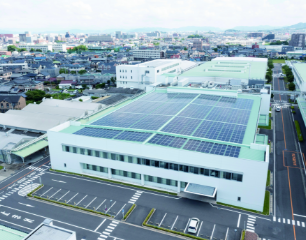
Headquarters/
Komaki Plant-
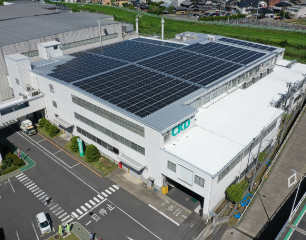
Kasugai Plant
-
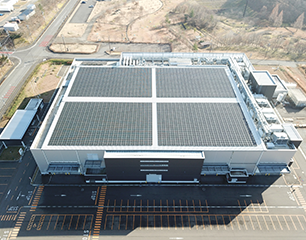
Touhoku Plant
-
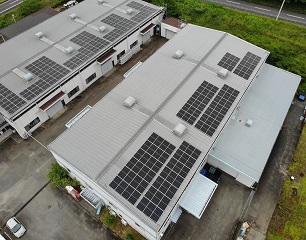
Shikoku Plant
-
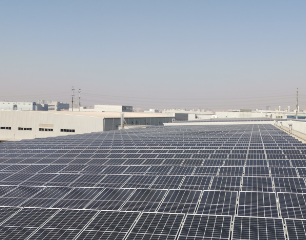
China Plant
-
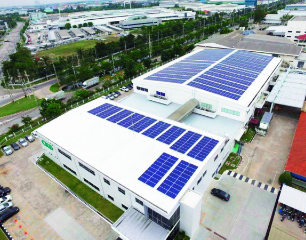
Thailand Plant
- ●Use of Green Power
-

-
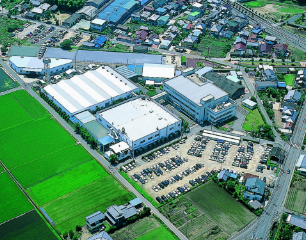
Inuyama Plant



